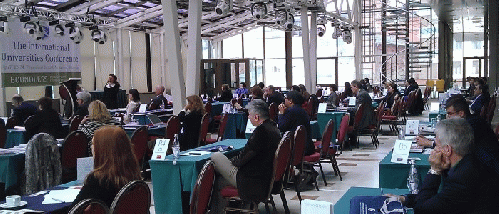The internationalization of the world's economic, political and cultural life stipulates not only the exchange of goods and capital but also knowledge exchange, as well as students and tutors exchange between HE institutions worldwide. Globalization of education has become a quite logical constituent of universal globalization and it is becoming crucial for universities from all over the world to keep pace with the arising internationalization issues by adjusting to the reshaping students' market and adopting a successful recruitment strategy.
If we take a look at Eurasia we can see that many of its countries have positioned themselves in the limelight as the largest sending countries. According to the Chinese Ministry of Education, a total of 399,600 Chinese students went to study abroad last year making China the largest sending country for international graduate students. This is very beneficial for Chinese students as they are get ting intercultural communication experience and become competitive on international market .
Another major education market player is India with an overwhelming quantity of international mobile students. The number of Indian students going overseas to study rose a stunning 256% -- from 53,266 to 189,629 -- in just nine years (2000--2009) according to a study of the Indian Institute of Management in Bangalore.
According to recent data t here were 106,104 young Vietnamese studying in 49 countries and territories in 2012 while Malaysia is predicted to become the world's sixth-biggest education exporting country by 2020 with a target of 200,000 international students. With a population of about 180 million, Pakistan is the world's sixth most populous country where t wo-thirds of the population are under the age of 30, and half are under 20 years old.
All these Eurasian countries are rapidly emerging as the largest source markets of tomorrow. Still most of these countries are interested not in one-way sending of students for getting complete education overseas, but rather in implementing students exchange and joint degree programmes (1+3, 2+2) thus giving students the opportunity to gain international experience and benefit from the best educational practices overseas and in their home countries.
Consequently, BRICs countries are pouring investment into higher education institutions in an effort to create world-class university systems. Remarkably Russia was included in top 20 best study destinations in the world according to a global research of the reputed US education firm Pearson . There is clear governmental support for Russian HE establishments , evidenced by budget expenditure on h igher e ducation that doubled between 2005 and 2011 (at US$ 14.5 billion).
Russia produces more academic graduates per academic year than any other European country which makes it a vast education market and a major host country . After the transition to the Bologna credit system Russian and other CIS universities have become more viable and compatible with the European HE establishments. At present CIS universities are faced with many new vistas and are eager to set up further cooperation with American and European universities by launching various programmes on acad emic exchange of students , tutors' exchange, joint or dual degrees, joint grant applications etc.
In terms of host countries , the British council report predicts that China, Malaysia and India could become major host countries in the coming decade. Last year China hosted 328,000 international students and its goal is half a million international students within the next two years.
According to the recent survey of Eastern European University Association (www.eeua.ru) 92,65% of CIS universities taking part in the survey have a functioning international relations department that deals with university's international activity.
35,82% of CIS universities offer graduate courses in English medium, 67,19% claimed that their university is allocated with a budget for international activity, 65,63% can boast having more than 5 active international partner universities.
This data clearly shows that CIS universities are interested and capable of establishing international cooperation with foreign peers. However the greatest challenge for foreign universities is finding "the meeting point" and actually getting to them. So how can a European or American university find reliable long-term partnership with universities in Eastern Europe or Asia?
International Universities Networking Conference (www.iunc.net) offers an excellent opportunity for setting up cooperation with a number of Eurasian universities and opens new avenues in international HE cooperation by providing a state-of-the-art networking platform .

Education
is an important area that is crucial in solving world problems not just for our
generation but also for generations to come. The u niversities must respond to the needs of students, faculty and their communities s o that each has the opportuni ty
to learn , study and thrive in the interconnected global
environment of the 21st century .
The Author: Zoya Tsybulnyk (EEUA Regional Manager)





